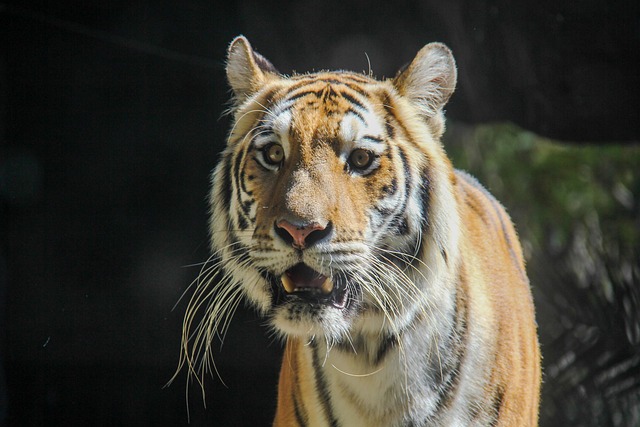The insect world is home to strange, menacing creatures that, if you were a little bug, you would be wise to steer clear of. Year after year, researchers uncover new species of ferocious creepy crawlies, monsters of the minibeast world. Parasitic wasps, exploding ants, beetles with punky hairdos, there is no shortage of grisly wonders. From Darth Vader sea bugs to fearsome ancient biters, here are some of the most disturbing discoveries from the insect world. Bug spray at the ready.
Related: 10 Creepy Appalachian Creatures That Will Make You Disappear
10 Bone Collector Caterpillar Wears Its Prey’s Body Parts
‘Bone collector’ caterpillar wears dead insect body parts as disguise
Hawai’i is home to a menacing-looking critter that knows how to make a fashion statement. The bone collector caterpillar decorates itself with the body parts of dead insects. The moth larvae build an outfit of pieces taken from spider webs. They munch away at dead or injured insects, then wear some of their prey as part of their silk casing. “It’s very serial killer-esque,” explained entomologist Daniel Rubinoff.
Scientists aren’t quite sure why the caterpillars build this macabre collection, but they think it might be for camouflage. The critters need to evade spiders while stealing prey from their webs. Researchers reckon the grisly outfits help them stay under the radar. However, they also make the larvae difficult to study. To date, the team from the University of Hawaiʻi has only found 62.[1]
9 Ancient Hell Ant Devoured Its Victims with Its Ferocious Jaws
The Reign of the Hell Ants
In a 2025 paper, scientists in Brazil announced that they had discovered the oldest-ever ant fossil with fearsome jaws. The University of São Paulo team describes the 113-million-year-old biter as a hell ant, an imposing predator that roamed at the same time as the dinosaurs. The fossil is roughly half an inch long and was found in a chunk of limestone at the Crato Formation quarry.
The insect belongs to a subfamily of hell ants known as Haidomyrmecinae. These lived tens of millions of years ago during the Cretaceous period. Scientists believe their front-facing jaws and horns allowed them to spear their prey. “It’s a very unusual kind of mandible that you can’t find in any insect today,” says Anderson Lepeco. However, it is thought that the hell ant’s restricted hunting style might also have been its undoing. As the Cretaceous period ended, scientists believe hell ants could not diversify, which led to their extinction.[2]
8 Crypt Keeper Wasp Warps the Minds of Other Species
Insidious wasp gets ahead by tunneling through host’s head
In 2019, scientists unveiled a parasitic wasp whose young invade the minds of other wasps and live in their dead bodies. They named the species Euredus set after the Egyptian god of chaos. The fiendish critters lay their eggs in the homes of another species, usually the gall wasp, who live in oak trees. Gall wasps create little growths in the trees, where parasitic crypt keepers lay their eggs.
When crypt keeper larvae hatch, the tiny bloodsuckers burrow into gall wasps’ bodies and start to control their minds. They make their hosts tunnel out of their swollen homes, forcing them to chew a hole too small to fit through. The larger wasps become stuck, and the parasites eat them from the inside. Crypt keeper larvae find it difficult to break out of the tree growths, so they emerge through the gall wasp’s head and into the world.[3]
7 Fuzzy Longhorn Beetle, the Punk Bug from Down Under
Meet the Fuzzy Beetle: A Never-Before-Seen Species!
A new beetle species in Australia has been described as a punk for its fuzzy white hair. According to Queensland researcher James Tweed, the bug has “a bit of a mohawk-type look.”
Tweed spotted the shaggy critter resting on a leaf while camping. At first, he dismissed it, thinking maybe it was bird poo. However, the government agency CSIRO confirmed that he had stumbled upon a new type of longhorn beetle. The bug is around a centimeter long, with an oikish hairdo that entomologists say is like nothing they have seen before.
“I worked with a couple of colleagues from the national insect collection, who literally wrote the book on these groups of beetles,” Tweed told reporters. “They examined tens of thousands of specimens in museums all over Australia and the world, and they’ve never found it before.”[4]
6 Exploding Ant Showers Attackers in Toxic Ooze
Exploding Ants Sacrifice Themselves To Save Their Colony
In the trees of Southeast Asia live ants with an unusual defense method: they blow themselves up. When attacked, exploding ants do exactly what the name suggests. The workers rip their bodies apart, killing themselves in the process, and spray toxic fluid at their foes.
In a 2018 study, researchers uncovered a new species of exploding ant in the leafy canopies of Borneo. Colobopsis explodens workers unleash yellow gunk as they explode. They tense up so hard that they rupture their abdomens, releasing a sticky yellow discharge. The soldiers, on the other hand, have huge heads with flat tops that they use to block up holes if the nest is breached.[5]
5 Pelican Spider Traps Its Prey with Spear-Like Legs
Pelican Spiders, Ancient Assassins That Eat Their Own Kind | ScienceTake
Going back to Queensland for this next entry, where, in 2024, researchers unveiled a new species of killer pelican spider. The eight-legged assassins have long, pointed limbs like spears. They use these to catch and kill smaller spiders for a tasty treat. Their reddish-brown bodies are a strange shape, even for an Aussie spider.
Scientists discovered the little menace during a wildlife survey of Conway National Park. Coming across a new species was a treat for the team. They called the crawlers Whitsunday hinterland pelican spiders.[6]
4 Darth Vader Sea Bug is a Foot-Long Menace
Meet the Darth Vader Sea Bug!
In a 2025 study, scientists discovered a new type of giant sea critter that resembles one of cinema’s most infamous villains. The giant Bathynomus vaderi can grow up to 12.8 inches (32.5 cm) long with a weight of 2.2 pounds (1 kg). But more frightening—they look like Darth Vader.
The shady-looking beasts live deep underwater, which makes them tough to study. To date, the only place scientists have found the huge bugs is in the South China Sea, close to the Spratly Islands. But they suspect more bugs are out there, lurking in the watery depths. Giant isopods like B. vaderi are now a delicacy in Vietnam, driving a surge in deep-sea fishing in the area. Researchers discovered the Darth Vader bug from a selection of creatures they picked up at a live seafood market.[7]
3 Peruvian Parasite Wasp Consumes Its Victims from the Inside Out
True Facts: Parasitoid Wasps
The Peruvian rainforest is home to a violent wasp that stabs its prey, drains their fluid, and eats them from the inside out. Scientists found the bloodthirsty bug at the National Reserve of Allpahuayo-Mishana and named it Capitojoppa amazonica. The prefix capito is due to its huge, swollen head.
The bright yellow parasites rub their antennae against other bugs to entice a host. They go for species like caterpillars, beetles, and spiders. When they find a host, the female pricks them with her tube-laying organ and releases a single egg inside their body. When larvae hatch, they eat the host from the inside out and form a tough shell or pupa inside the remains. They only surface when they have grown into adult wasps. In some cases, “females will even stab the host with the ovipositor and feed without laying an egg,” says Brandon Claridge of Utah State University.
Scientists discovered all kinds of creatures in the rainforests of Peru. The parasitic wasp was one of over 100 new species caught using malaise traps.[8]
2 Movile Cave Centipede Is the King of a Toxic Pit
Cryptops speleorex – Cienpies Amarillo
Under the earth in Romania lies a poisonous cave brimming with strange, hardy creatures. Movile Cave is 65 feet (20 meters) below the ground and dense with toxic gas. It seems like it should be a barren wasteland, but over 50 species call the cave home, including scorpions, spiders, snails, and leeches. At the top of the ecosystem sits a brutal centipede named Cryptops speleorex, first discovered in 2020.
The bug is only a few inches long, but it is still one of Movile Cave’s largest, most ruthless predators. C. speleorex has a yellow-brown body, and its legs are covered in saw teeth. Scientists say the species is related to other centipedes found on the surface in Eastern Europe. But millions of years in a toxic cave without sunlight have forced the creature to adapt by extending its antennae and growing more saw teeth on its legs.[9]
1 Lord Voldemort Ant Is a Ghostly Underground Predator
New species of Ant Discovered in Australia, Named after Voldemort
It takes an especially spine-chilling beast to earn the name of the Dark Lord of the wizarding world. The Lord Voldemort ant, or Leptanilla voldemort, is a pale creature that lives in the dry Pilbara region of northwest Australia. Scientists named it after the Harry Potter villain for its ghostly look and spindly body.
The Voldemort ant dwells deep underground. Retrieving the species took creative new methods. Scientists from the University of Western Australia captured two specimens using a subterranean scraping technique. They drilled an 82-foot (25-meter) hole in the ground, then scraped a net against the inside of the hole.
Little is known about how the ant hunts in the murky depths. But scientists claim it is “almost surely a predator, a fearsome hunter in the dark.” The team believes they use their piercing mandibles and cutting jaws to take down larger creatures that live under the earth. They reckon the ants feast on centipedes, flies, and beetles. The Voldemort ant is only the second Leptanilla species discovered in Australia. There is still much to learn about their elusive life in the soil.[10]
fact checked by
Darci Heikkinen



